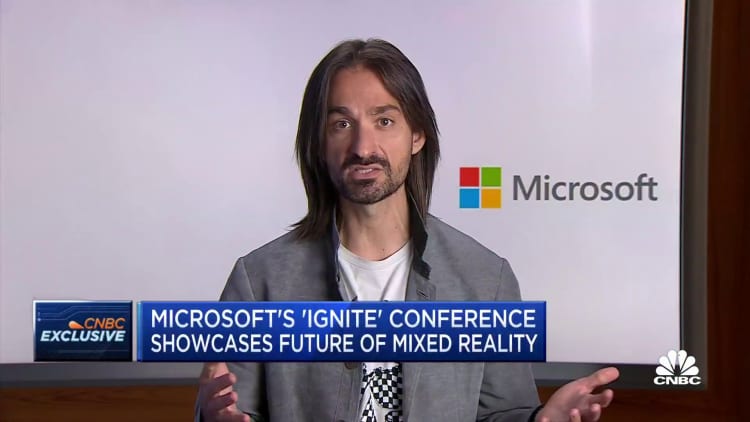
Microsoft on Tuesday announced Mesh, a service to build apps for people to collaborate in augmented reality.
Augmented reality (AR) shows computer-generated images superimposed over the real world, and nearly all the major tech players are working on the technology as they strive to create the next computing platform that will replace the smartphone. However, AR headsets today are often clunky and expensive -- Microsoft's HoloLens starts at $3,500 -- and so far they've mainly been used in industrial applications. Apple and Facebook are reportedly building their own AR headsets or glasses for release over the next couple of years, which could help validate the market for consumers and create a sort of AR gold rush.
With Mesh, Microsoft wants to ensure that people who don't have AR systems can participate in virtual gatherings with those who do. The goal is to enable people to join Mesh-enabled meetings on any device, such as a PC, a tablet or a smartphone. It will also work with virtual reality (VR) headsets -- a slightly different class of device that immerse people in a computer-generated world but block out the physical environment, and are generally cheaper and more common than AR headsets. For example, HP sells a VR device that works with Windows, the Reverb G2, for $600.
To illustrate what Mesh can do, Microsoft built a sample app that runs on the HoloLens.
After putting on a HoloLens and opening the app, a person can design an avatar to represent themselves and join a meeting with other people, whose avatars appear like holograms. People's heads, bodies and hands can all move thanks to the information the headsets capture, and it's possible to talk with everyone, similar to a video call. Additionally, users can import, display and manipulate ready-made and custom three-dimensional holograms. Three-dimensional drawing tools are available, too.
To demonstrate the technology more broadly, the company is coming out with a Mesh-enabled version of AltspaceVR, a VR meeting app. Customers can request to download the app. Microsoft acquired AltspaceVR in 2017 for undisclosed terms.
Over time, Microsoft plans to incorporate Mesh into its own applications, such as the Teams collaboration app that has become more widely used during the Covid pandemic as a way for co-workers to meet without being in the office.
Mesh will be an Azure service and associated software development kit. Select customers can start testing the Mesh cloud service now in preview before it becomes more widely available. Microsoft has not disclosed how much it will cost to use the service. Azure is a public cloud service for hosting applications.
Microsoft derives less than 5% of its revenue from devices, while one analyst estimates that Azure represents 17% of revenue. Azure revenue grew 50% year over year in the fourth quarter, while devices revenue increased less than 4%.
WATCH: Here's how Microsoft's augmented reality headset will make Army soldiers deadlier



